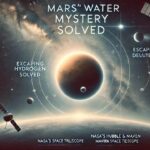“NASA GRX-810 superalloy, aerospace innovation, 3D-printable materials, high-temperature alloys, aerospace engineering, sustainable aviation, space exploration technology, NASA technology transfer, economic impact of space technology”
“Explore how NASA’s new GRX-810 superalloy is set to revolutionize the aerospace industry with improved durability and efficiency. Learn about the alloy’s capabilities, its commercialization through licensing to U.S. companies, and the economic benefits of this cutting-edge technology.”

NASA has consistently been at the forefront of scientific and technological advancements, contributing significantly to both space exploration and economic growth. The latest innovation from NASA, the GRX-810 superalloy, is set to revolutionize the aerospace industry by offering unparalleled durability and efficiency in aircraft and spacecraft components. This development is not just a technological achievement but also a strategic economic booster through its licensing to U.S. companies.
The Genesis of NASA GRX-810 Superalloy
Developed at NASA’s Glenn Research Center in Cleveland, Ohio, GRX-810 is the culmination of cutting-edge research in material science tailored for the extreme conditions of aerospace operations. The superalloy was designed by a team of engineers, including Dr. Tim Smith and Christopher Kantzos, who employed advanced computer modeling and innovative 3D-printing technology. This technology, which involves laser-printing layers of metal fused together, incorporates tiny particles that enhance the alloy’s strength and durability.
NASA GRX-810 Superalloy Characteristics and Capabilities
GRX-810 is primarily crafted for high-temperature applications in air and space environments, such as liquid rocket engine injectors, combustors, and turbines. It can withstand temperatures exceeding 2,000 degrees Fahrenheit and offers remarkable improvements over traditional nickel-base alloys. Notably, it is capable of enduring higher temperatures and stress, lasting up to 2,500 times longer, and is significantly more flexible and resistant to oxidation than its predecessors.
Commercialization and Economic Impact of NASA GRX-810 Superalloy
In a move to maximize the impact of taxpayer-funded research, NASA has licensed GRX-810 to four American companies under co-exclusive agreements. These companies include Carpenter Technology Corporation in Pennsylvania, Elementum 3D, Inc. in Colorado, Linde Advanced Material Technologies, Inc. in Indiana, and Powder Alloy Corporation in Ohio. This strategic licensing allows these firms to manufacture and market the superalloy, ensuring that the benefits of this NASA-developed technology are diffused throughout the airplane and rocket manufacturing supply chain.
NASA GRX-810 Superalloy Enhancing U.S. Economic Growth
The licensing of GRX-810 is a prime example of how governmental research can foster economic development. According to Amy Hiltabidel, a licensing manager at NASA’s Glenn Research Center, this approach not only helps in advancing technology but also ensures that the U.S. economy benefits directly from these developments. The commercial adoption of GRX-810 is anticipated to lead to more sustainable aviation and space exploration technologies, which in turn will reduce operating costs, increase fuel efficiency, and prolong the operational lifespan of aerospace components.
Broader Implications of NASA GRX-810 Superalloy
The development and commercialization of GRX-810 also underscore NASA’s broader commitment to transforming its technological innovations into practical applications that support American industries. Through its Technology Transfer Program, NASA reviews new technologies, files for patents, and works with inventors and industries to foster commercialization. To date, NASA has facilitated the spinoff of over 2,000 technologies, significantly contributing to the U.S. economy and enhancing global competitiveness.
Future Prospects of NASA GRX-810 Superalloy
The introduction of GRX-810 into the market is expected to set new standards in aerospace manufacturing, with potential applications expanding into other industries facing extreme operational conditions. The ongoing collaboration between NASA, academic institutions like The Ohio State University, and other research centers, including NASA’s Ames Research Center and Marshall Space Flight Center, continues to propel forward the boundaries of what is technologically possible.
In conclusion, GRX-810 is not just a testament to NASA’s innovation in aerospace technology but also an example of how strategic licensing of such technologies can enhance economic growth, sustain industrial competitiveness, and lead to more robust and efficient operational capabilities in challenging environments. This development marks a significant step forward in the symbiotic relationship between space exploration and economic development, promising a brighter, more efficient future in aerospace and beyond.
Read More-
- NASA Webb Telescope Hints at Possible Atmosphere Surrounding Rocky Exoplanet
- New NASA Black Hole Visualization Takes Viewers Beyond the Brink
- NASA Artemis Generation: Cultivating the Moon Trees Across America
- NASA Fermi Reveals the Universe in New E-Book










